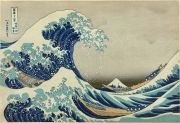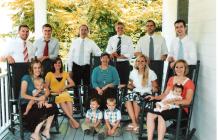 Reader Question:
Reader Question:
Dave, can you please provide a list of poems that your family has enjoyed over the years? Our family really likes poetry, and it may be useful to have a handy list around. We would truly appreciate whatever guidance you choose to give or poetry you might suggest.
Family Answer:
Thanks for your question. Sincere, honest questions are always a good thing.
To gather an answer to your question, we talked to our adult kids, and here’s the list that we gathered. Note that this will be a living list, a living post, that we will add to over time as we remember other poems or experience new ones that we wish to include.
For us, poetry is an ancient, vital language. It limbers up our imagination. Here’s the MormonPanorama Poetry List for helping to stretch the minds of your family. These are for a general audience unless otherwise marked, and parents are encouraged to read beforehand and judge for themselves.
- Anchored to the Infinite (Published 1929) — Edwin Markham
- Annabel Lee (1849) — Edgar Allen Poe
- Birches (1916) — Robert Frost
- Cicadas at the End of Summer (2000) — Martin Walls
- Concord Hymn (1837) — Ralph Waldo Emerson
- Crossing the Bar (1889) — Alfred, Lord Tennyson
- Devils, or Бесы (1830) — Alexander Pushkin
- Day of Crispian Speech, King Henry V in Henry V, Act IV, Scene 3, lines 42-69; also see lines 17-136 (Published Year 1600) — William Shakespeare (“the Bard”)
- Einstein’s Happiest Moment (2000) — Richard M. Berlin
- Experience (1844) — Ralph Waldo Emerson
- Fire and Ice (1920) — Robert Frost
- Gunga Din (1892) — Rudyard Kipling
- Hard to Forget (no date) — O. Henry
- How Easily Are Bishops Made [quoted in C. Beaufort Moss, The Divisions of Christendom: A Retrospect (n.d., “no date”), Page 22] and other poems of various sorts by Charles Wesley
- Mending Wall (1914) — Robert Frost
- My Lost Youth (no date) — Henry Wadsworth Longfellow
- O Captain! My Captain! (1865) — Walt Whitman
- Ode: Intimations of Immortality from Recollections of Early Childhood (1807) — William Wordsworth
- Ode to Stephen Dowling Bots, Dec’d. (1865) — Mark Twain
- Our Birth Is But a Sleep and a Forgetting, from Ode: Intimations of Immortality from Recollections of Early Childhood , lines 59-77 (Published Year 1807) — William Wordsworth
- Our doubts are traitors, Lucio to Isabella in Measure for Measure, Act I, Scene 4, lines 84-86 (first performed 1604, first published Year 1623) — William Shakespeare (“the Bard”)
- Outwitted (1929?) — Edwin Markham
- Paul Revere’s Ride (1861) — Henry Wadsworth Longfellow
- Pompeii (2008) — Charles Bernstein
- Reluctance (1913) — Robert Frost
- Sleep (no date) — Jorge Luis Borges
- Snow flakes. (45) (1945) — Emily Dickinson
- Sonnet 94: They that have power to hurt and will do none (1609) — William Shakespeare (“the Bard”)
- Sonnet 106: When in the chronicle of wasted time (1594) — William Shakespeare (“the Bard”)
- Sonnet 107: Not mine own fears, nor the prophetic soul (1575) — William Shakespeare (“the Bard”)
- Stopping by Woods on a Snowy Evening (1923) — Robert Frost
- The Charge of the Light Brigade (1854) — Alfred, Lord Tennyson
- The Giraffe (no date) — Ogden Nash
- The Highwayman (1906) — Alfred Noyes
- The Pasture (no date) — Robert Frost
- The Raven (1845) — Edgar Allen Poe
- The Road Not Taken (1916) — Robert Frost
- There Is a Tide in the Affairs of Men, Marcus Brutus in Julius Caesar, Act IV, Scene 3, lines 217-223 (Published Year 1599) — William Shakespeare (“the Bard”)
- Too Many Daves (1961) — Dr. Seuss (Theodor Seuss Geisel)
- Warm Summer Sun (1888) — Mark Twain
- When I Heard the Learn’d Astronomer (1860) — Walt Whitman
- Written in a Copy of the Geste of Beowulf (no date) — Jorge Luis Borges
- Extended poetry list from MormonPanorama — A post with additional space in order to include selected excerpts of poems or complete poems that don’t have their own webpage
What we were looking for in poetry for kids as they grew up:
- Poetry that gave us material to discuss – especially about what is right and what is wrong and how to resist wrongs that are embraced by so many others around you.
- Poems that build up rather than drag down, that uplift and inspire.
- We avoided literature which stated that our moral standards are silly or which encouraged us to become less than we should be.
We hope this answers your question and helps you understand us better and how to become a more effective family, create strong citizens, and have fun with our youth and young adults.
And let us know how we may help you further! If you find that you have any questions about religious issues that you’ve been wondering about or that you haven’t been able to get good answers to, feel free to continue on discussion with us. It turns out that there are a lot of people with questions, and most of them have given up on churches as a source of answers. In our family, it is our experience that answers are out there, that God wants us to have them, and that they tend to be answers we like and have learned to appreciate. Working together with Heavenly Father allows anyone to find certainty in uncertain times.
-Dave and the MormonPanorama Family
——– End of Post ——–
Bonus Material:
1. 90% of People can’t pronounce this whole poem. Feel free to try it!
2. Monty Python on poetry—Kind of…
——– End of Bonus Material ——–
WebCredits—List of web resources used in this post but not explicitly credited above:
- Photo, ocean-oregon-coast—www. lds.org/media-library/images/oceans?lang=eng
- Photo, ocean-pacific-grove—www. lds.org/media-library/images/oceans?lang=eng
——– End of WebCredits ——–























